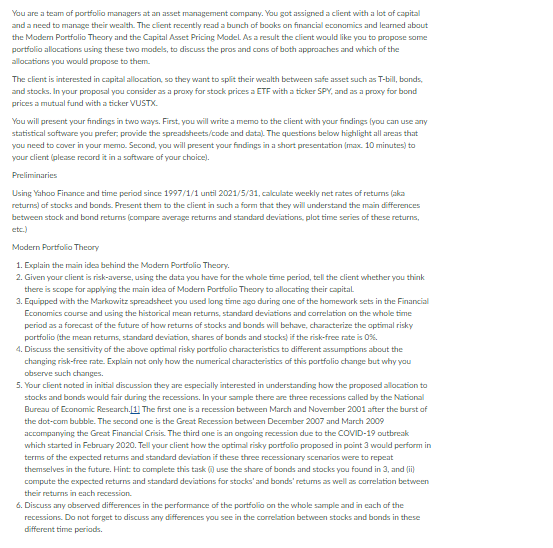
You are a team of portfolio managers at an asset management company. You got assigned a client with a lot of capital and a need to manage their wealth. The client recently read a bunch of books on financial economics and learned about the Modern Portfolio Theory and the Capital Asset Pricing Model As a result the client would like you to propose some portfolio allocations using these two models, to discuss the pros and cons of both approaches and which of the allocations you would propose to them The client is interested in capital allocation, so they want to split their wealth between safe asset such as T-bill, bonds. and stocks. In your proposal you consider as a proxy for stock prices a ETF with a ticker SPY, and as a prooey for bond prices a mutual fund with a ticker VUSTX. You will present your findings in two ways. First, you will write a memo to the client with your findings you can use any statistical software you prefer, provide the spreadsheets/code and data. The questions below highlight all areas that you need to cover in your memo. Second, you will present your findings in a short presentation (max. 10 minutes) to your client (please record it in a software of your choice). Preliminaries Using Yahoo Finance and time period since 1997/1/1 until 2021/5/31, calculate weekly net rates of returns (aka returne) of stocks and bonds. Present them to the client in such a form that they will understand the main differences between stock and bond returns (compare average returns and standard deviations, plot time series of these returns, etc.) Modern Portfolio Theory 1. Explain the main idea behind the Modern Portfolio Theory. 2. Given your client is risk-averse, using the data you have for the whole time period, tell the client whether you think there is scope for applying the main idea of Modern Portfolio Theory to allocating their capital 2. Equipped with the Markowitz spreadsheet you used long time ago during one of the homework sets in the Financial Economics course and using the historical mean returns, standard deviations and correlation on the whole time period as a forecast of the future of how returns of stocks and bonds will behave, characterize the optimal risky portfolio (the mean retums, standard deviation, shares of bonds and stocks) if the risk-free rate is 0%. 4. Discuss the sensitivity of the above optimal risky portfolio characteristics to different assumptions about the changing risk-free rate. Explain not only how the numerical characteristics of this portfolio change but why you observe such changes 5. Your client noted in initial discussion they are especially interested in understanding how the proposed allocation to stocks and bonds would fair during the recessions. In your sample there are three recessions called by the National Bureau of Economic Research.[1] The first one is a recession between March and November 2001 after the burst of the dot-com bubble. The second one is the Great Recession between December 2007 and March 2009 accompanying the Great Financial Crisis. The third one is an ongoing recession due to the COVID-19 outbreak which started in February 2020. Tell your client how the optimal risky portfolio proposed in point 3 would perform in terms of the expected returns and standard deviation if these three recessionary scenarios were to repeat themselves in the future. Hint to complete this taskuse the share of bonds and stocks you found in 3, and (ii) compute the expected returns and standard deviations for stock and bonds' returns as well as correlation between their returns in each recession 6. Discuss any observed differences in the performance of the portfolio on the whole sample and in each of the recessions. Do not forget to discuss any differences you see in the correlation between stocks and bonds in these different time periods. You are a team of portfolio managers at an asset management company. You got assigned a client with a lot of capital and a need to manage their wealth. The client recently read a bunch of books on financial economics and learned about the Modern Portfolio Theory and the Capital Asset Pricing Model As a result the client would like you to propose some portfolio allocations using these two models, to discuss the pros and cons of both approaches and which of the allocations you would propose to them The client is interested in capital allocation, so they want to split their wealth between safe asset such as T-bill, bonds. and stocks. In your proposal you consider as a proxy for stock prices a ETF with a ticker SPY, and as a prooey for bond prices a mutual fund with a ticker VUSTX. You will present your findings in two ways. First, you will write a memo to the client with your findings you can use any statistical software you prefer, provide the spreadsheets/code and data. The questions below highlight all areas that you need to cover in your memo. Second, you will present your findings in a short presentation (max. 10 minutes) to your client (please record it in a software of your choice). Preliminaries Using Yahoo Finance and time period since 1997/1/1 until 2021/5/31, calculate weekly net rates of returns (aka returne) of stocks and bonds. Present them to the client in such a form that they will understand the main differences between stock and bond returns (compare average returns and standard deviations, plot time series of these returns, etc.) Modern Portfolio Theory 1. Explain the main idea behind the Modern Portfolio Theory. 2. Given your client is risk-averse, using the data you have for the whole time period, tell the client whether you think there is scope for applying the main idea of Modern Portfolio Theory to allocating their capital 2. Equipped with the Markowitz spreadsheet you used long time ago during one of the homework sets in the Financial Economics course and using the historical mean returns, standard deviations and correlation on the whole time period as a forecast of the future of how returns of stocks and bonds will behave, characterize the optimal risky portfolio (the mean retums, standard deviation, shares of bonds and stocks) if the risk-free rate is 0%. 4. Discuss the sensitivity of the above optimal risky portfolio characteristics to different assumptions about the changing risk-free rate. Explain not only how the numerical characteristics of this portfolio change but why you observe such changes 5. Your client noted in initial discussion they are especially interested in understanding how the proposed allocation to stocks and bonds would fair during the recessions. In your sample there are three recessions called by the National Bureau of Economic Research.[1] The first one is a recession between March and November 2001 after the burst of the dot-com bubble. The second one is the Great Recession between December 2007 and March 2009 accompanying the Great Financial Crisis. The third one is an ongoing recession due to the COVID-19 outbreak which started in February 2020. Tell your client how the optimal risky portfolio proposed in point 3 would perform in terms of the expected returns and standard deviation if these three recessionary scenarios were to repeat themselves in the future. Hint to complete this taskuse the share of bonds and stocks you found in 3, and (ii) compute the expected returns and standard deviations for stock and bonds' returns as well as correlation between their returns in each recession 6. Discuss any observed differences in the performance of the portfolio on the whole sample and in each of the recessions. Do not forget to discuss any differences you see in the correlation between stocks and bonds in these different time periods







